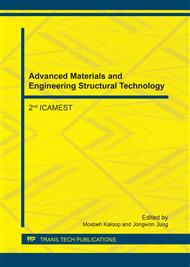[1]
H. Fan, H. Li, L. Z. Fan, Q. Shi, Preparation and electrochemical properties of gel polymer electrolytes using triethylene glycol diacetate-2-propenoic acid butyl ester copolymer for high energy density lithium-ion batteries, J. Pow. Sour. 249 (2014).
DOI: 10.1016/j.jpowsour.2013.10.112
Google Scholar
[2]
C. Zhang, X. Yang, W. Ren, Y. Wang, F. Su, J. X. Jiang, Microporous organic polymer-based lithium ion batteries with improved rate performance and energy density, J. Pow. Sour. 317 (2016) 49–56.
DOI: 10.1016/j.jpowsour.2016.03.080
Google Scholar
[3]
A. M. M. Ali, R. H. Y. Subban, H. Bahron, M. Z. A. Yahya, A. S. Kamisan, Investigation on modified natural rubber gel polymer electrolytes for lithium polymer battery, J. Pow. Sour. 244 (2013) 636–640.
DOI: 10.1016/j.jpowsour.2013.01.002
Google Scholar
[4]
J. H. Baik, D. G. Kim, J. Shim, J. H. Lee, Y. S. Choi, J. C. Lee, Solid polymer electrolytes containing poly(ethylene glycol) and renewable cardanol moieties for all-solid-state rechargeable lithium batteries, Polym. (United Kingdom). 99 (2016).
DOI: 10.1016/j.polymer.2016.07.058
Google Scholar
[5]
L. Yue, J. Ma, J. Zhang, J. Zhao, S. Dong, Z. Liu, G. Cui, L. Chen, All solid-state polymer electrolytes for high-performance lithium ion batteries, Energy Storage Mater. 5 (2016) 139–164.
DOI: 10.1016/j.ensm.2016.07.003
Google Scholar
[6]
B. Liang, Q. Jiang, S. Tang, S. Li, X. Chen, Porous polymer electrolytes with high ionic conductivity and good mechanical property for rechargeable batteries, J. Pow. Sour. 307 (2016) 320–328.
DOI: 10.1016/j.jpowsour.2015.12.127
Google Scholar
[7]
K. Nazir, S. F. Ayub, A. F. Aziz, A. M. M. Ali, M. Z. A. Yahya, Preparation and Characterization of Epoxidized-30% Poly(methyl methacrylate)-grafted Natural Rubber Polymer Electrolyte, J. Nano Res. 28 (2014) 163–170.
DOI: 10.4028/www.scientific.net/jnanor.28.163
Google Scholar
[8]
N. H. M. Zaki, Z. S. Mahmud, N. I. Adam, A. H. Ahmad, A. M. M. Ali, M. Z. A. Yahya, Characterization of plasticized grafted natural rubber-30% poly (methyl methacrylate) (MG30) based polymer electrolytes, 2012 IEEE Symp. Business, Eng. Ind. Appl. Charact. (2012).
DOI: 10.1109/isbeia.2012.6422981
Google Scholar
[9]
A. M. M. Ali, M. Z. A. Yahya, H. Bahron, R. H. Y. Subban, Electrochemical studies on polymer electrolytes based on poly(methyl methacrylate)-grafted natural rubber for lithium polymer battery, Ionics (Kiel). 12 (2006) 303–307.
DOI: 10.1007/s11581-006-0052-0
Google Scholar
[10]
K. S. Yap, L. P. Teo, L. N. Sim, S. R. Majid, A. K. Arof, Investigation on dielectric relaxation of PMMA-grafted natural rubber incorporated with LiCF3SO3, Phys. B Condens. Matter. 407 (2012) 2421–2428.
DOI: 10.1016/j.physb.2012.03.039
Google Scholar
[11]
Z. Cibulková, P. Šimon, P. Lehocký, J. Balko, Antioxidant activity of p-phenylenediamines studied by DSC, Polym. Degrad. Stab. 87 (2005) 479–486.
DOI: 10.1016/j.polymdegradstab.2004.10.004
Google Scholar
[12]
Z. Cibulková, P. Lehock, K. Kosár, A. Chochulová, DSC study of antioxidant activity of selected p -phenylenediamines in styrene-butadiene rubber, J. Therm. Anal. Calorim. 97 (2009) 535–540.
DOI: 10.1007/s10973-008-9628-4
Google Scholar
[13]
F. Cataldo, On the ozone protection of polymers having non-conjugated unsaturation, Polym. Degrad. Stab. 72 (2001) 287–296.
DOI: 10.1016/s0141-3910(01)00017-9
Google Scholar
[14]
A. F. Aziz, A. M. M. Ali, Thermal oxidation studies on methyl grafted natural rubber polymer electrolytes with paraphenylene diamine additive, 2012 IEEE Colloq. Humanit. Sci. Eng. (2012) 719–723.
DOI: 10.1109/chuser.2012.6504406
Google Scholar
[15]
A. L. Saroj, R. K. Singh, Thermal, dielectric and conductivity studies on PVA/Ionic liquid [EMIM][EtSO4] based polymer electrolytes, J. Phys. Chem. Solids. 73 (2012) 162–168.
DOI: 10.1016/j.jpcs.2011.11.012
Google Scholar
[16]
C. Nah, J. H. Park, C. T. Cho, Y. W. Chang, S. Kaang, Specific heats of rubber compounds, J. Appl. Polym. Sci. 72 (1999) 1513–1522.
DOI: 10.1002/(sici)1097-4628(19990620)72:12<1513::aid-app2>3.0.co;2-i
Google Scholar
[17]
A. Vallée, S. Besner, J. Prud'Homme, Comparative study of poly(ethylene oxide) electrolytes made with LiN(CF3SO2)2, LiCF3SO3 and LiClO4: Thermal properties and conductivity behaviour, Electrochim. Acta. 37 (1992) 1579–1583.
DOI: 10.1016/0013-4686(92)80115-3
Google Scholar
[18]
P. K. Varshney, S. Gupta, Natural polymer-based electrolytes for electrochemical devices: a review, Ionics (Kiel). 17 (2011) 479–483.
DOI: 10.1007/s11581-011-0563-1
Google Scholar
[19]
A. M. M. Ali, R. H. Y. Subban, H. Bahron, T. Winie, F. Latif, M. Z. A. Yahya, Grafted natural rubber-based polymer electrolytes: ATR-FTIR and conductivity studies, Ionics (Kiel). 14 (2008) 491–500.
DOI: 10.1007/s11581-007-0199-3
Google Scholar
[20]
W. Huang, R. Frech, Raman spectra of PPO-salt complexes: Mixed cations and mixed anions, Solid State Ionics. 53–56 (1992) 1095–1101.
DOI: 10.1016/0167-2738(92)90296-2
Google Scholar
[21]
A. K. Arof, S. Amirudin, S. Z. Yusof, I. M. Noor, A method based on impedance spectroscopy to determine transport properties of polymer electrolytes. Phys. Chem. Chem. Phys. 16 (2014) 1856–67.
DOI: 10.1039/c3cp53830c
Google Scholar


